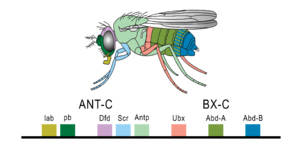Hox gene facts for kids
Hox genes are a special group of genes that act like master controllers for how an animal's body is built. They decide where body parts like legs, wings, or ribs should go. The word 'Hox' is short for 'homeobox', which is a key part of these genes.
These genes are super important during the early stages of an animal's life, when it's just a tiny embryo. For example, in fruit flies, Hox genes make sure the legs, antennae, and wings grow in the right places. In humans, they help make sure our ribs and other vertebrate parts form correctly.
Hox genes create special proteins. These proteins attach to other genes, telling them what to do. They can either turn other genes on or off. This process guides the cells to develop into the correct body parts.
- Hox genes contain a specific part of their DNA called the homeobox. This homeobox is a short section of DNA, 180 nucleotides long. It gives instructions to make a small protein part called a homeodomain. This homeodomain is what helps the Hox protein stick to other DNA.
- Hox genes are usually found grouped together in specific spots on a chromosome. These groups are called gene clusters.
- The order of these genes on the chromosome matches the order in which they work along an animal's body. For example, genes at one end of the cluster control the head, while genes at the other end control the tail.
- This group of master control genes helps program the development of many different animals, from flies to humans.
- These gene clusters are very old in terms of evolution. They haven't changed much over hundreds of millions of years. Scientists believe that some Hox genes existed even before the earliest animals with two sides (like us!). This means the system developed a very long time ago.
Contents
How Hox Genes Are Arranged
In many animals, especially those with backbones (vertebrates), the different Hox genes are found very close to each other on the chromosome. They form tight groups called clusters.
The way these genes are lined up on the chromosome is usually the same as the order in which they become active in the developing embryo. For instance, the first gene in the cluster often controls the front part of the animal. Scientists are still working to fully understand why this "co-linearity" (matching order) happens. The diagram above shows how these genes and their proteins relate in flies.
Found in All Animals
The special homeodomain protein part is very similar in most animals. Even in animals like jellyfish, which are simpler, you can find variations of these proteins. This similarity suggests that all Hox gene clusters likely came from a single original Hox gene. Over time, this single gene copied itself many times, leading to the clusters we see today.
Scientists think that the common ancestor of all animals with two symmetrical sides (like humans, dogs, and insects) probably had a Hox gene cluster with at least seven different Hox genes.
Hox Genes in Humans
Humans have a total of 39 Hox genes. These genes are organized into clusters on four different chromosomes in our bodies.
Related Topics
Images for kids
See also
 In Spanish: Genes Hox para niños
In Spanish: Genes Hox para niños





